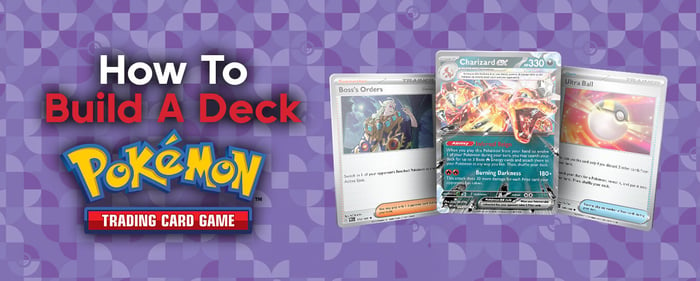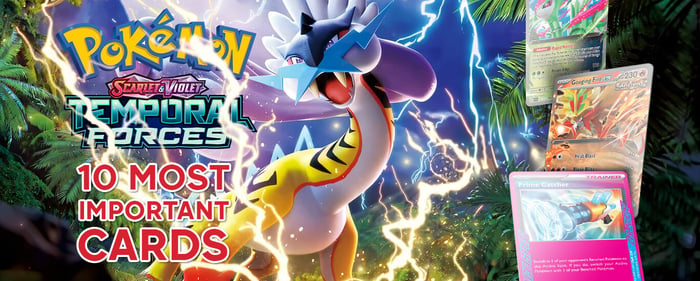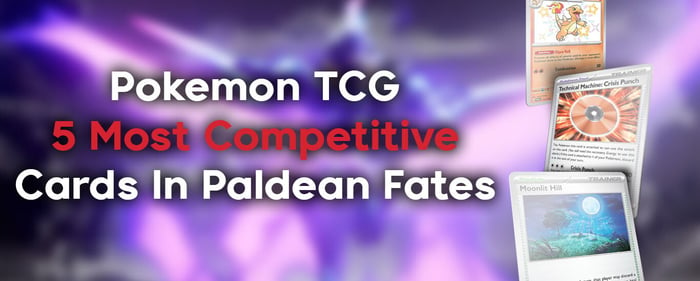The Pokémon TCG continues to take trainers to the depths of new regions. With new releases, such as the current exploration of Paldea, it’s a hugely exciting time to build your own battle-ready deck.
Yet, delving into deck building for the Pokémon TCG can be daunting – new terminology, a myriad of strategies, and an ever-shifting meta often make it feel difficult to begin.
That needn’t be the case. There are basic principles, solid starting points, and TCG strategies that enable you to battle opponents using carefully curated decks, incorporating some of your Pokémon.
So, how do you do it?
Table of Contents
Get a feel for the rules
To be able to feel comfortable building your own deck, it’s useful to wrap your head around the rules used in Pokémon TCG battles. That way, you’ll be able to recognise why certain types of cards are needed in your build and how they’ll work together as the battle plays out.
For the absolute basics, a deck is made up of 60 cards, and it can’t contain more than four copies of the same card (except for basic energy cards). You’ll figure out how to get your own even distribution of required cards.
You can have one active Pokémon on your side of the field which can attack once per turn, and then up to five Pokémon waiting in the wings on your bench. You’ll use your active Pokémon to try knock out your opponent’s Pokémon.
You can win a Pokémon TCG battle by taking all of your six prize cards by knocking out your opponent’s Pokémon (different Pokémon equate to different numbers of prize cards), leaving your opponent with no Pokémon in-play, or running their deck down so that they have no cards left to draw.
The TCG also has a number of playable formats, though the two most popular are standard and expanded.
Standard – the most widely played – sees expansions rotate out each year to keep play fresh. For example, cards with the E regulation mark will no longer be legal for play in the 2024 Standard format as of March. Cards with F, G and H regulation marks will be legal to use (as will any future regulation marks that may be released).
In Expanded format, a greater number of expansions are available to play compared to the Standard format. That said, it is not as unpredictable in card combinations as the third format called Unlimited where any card that has previously been legal is playable.
Decide on your battle style
Your battle style will determine the way in which you are likely to achieve victory, so it’s important to identify how you’ll be playing as you build out your deck.
Do you prefer the idea of stretching out the game and creating a snooze-fest using a bulky Snorlax until your opponent has no more cards to draw? Maybe you prefer an aggressive, gung-ho approach that takes the game to your opponent’s Pokémon, knocking them out as quickly as possible so you can pick up prize cards? Or could it be that your style is to take control of the game, cutting off your opponent’s resources with your well-thought-out strategies?
Whatever it is, you’ll be able to bring it to life with your Pokémon’s attacks and abilities, tools, items and more. Identify this from the outset and go from there.
Select your main attackers
Next, you’ll need to choose your main attackers that fit your battle style. These are the nucleus of your deck, which the rest of your cards will be built around, supporting and facilitating their best features.
Naturally, you’ll want four copies of these game-winning cards in the deck to maximise your chances of drawing them and getting them into play.
Popular main attackers used in the Pokémon TCG continually rotate based on new releases and usage, so it can be useful to investigate what other trainers are adding to their decks. You could have a Giratina V Star supporting your aggressive strategy, or a Blissey V using its bulk and ability to slow things right down.
It’s also important to think about how the typing of your main Pokémon will match up against other decks that are currently popular in the meta, but we can find ways to adjust for this a little later on.
Don’t forget your pre-evolutions
To be able to get your main Pokémon set up on field, you’ll need to evolve them. For this reason, it’s vital we include pre-evolutions for each stage for the Pokémon, making sure it is equivalent to the number of final stage Pokémon we have.
For example, if you have four copies of Charizard ex, then you’ll also need four Charmeleons and four Charmanders so that you can evolve them into that intimidating final form.
You’ll want pre-evolutions for all the necessary Pokémon cards in your deck, not just your main attacker, as the same principles apply throughout.
These cards obviously take up space in your deck, so it is possible to consider workarounds with basic Pokémon as your main attacker. However that will usually come at a cost as they typically deal out less damage. Though Mew may have a thing or two to say…
Integrate secondary attackers
Beyond your main attacker, you should also add secondary attackers to your deck. These Pokémon cover for any deficiencies your main attacker may have, such as type weaknesses, while also holding enough power to knock out your opponent’s Pokémon and take prize cards.
For example, a deck containing Giratina V Star as the main attacker may also want to include Radiant Greninja to add that extra level of verve helping to clean up the opponent's board, or even Drapion V to hard-counter Mew V Max with its bludgeoning Dynamic Tail attack.
It’s always good to consider how these secondary attackers compliment your overall strategy too. The Mew V Max archetype, which left its mark on the TCG, brings together the techy-terrifying bug Genesect V (Fusion Strike) to deal out damage and also fill up your hand with its Fusion Strike System ability. If you build the deck correctly with subsequent supportive attackers from the Fusion Strike series, then you have a way to quickly weaponise your Mew V Max and Genesect V so you can OHKO almost any Pokémon.
But amongst all this furore, you must still remember those pre-evolutions if they’re needed, people.
Add support Pokémon
The final set of Pokémon that you’ll want to include in your deck are those that support your overall strategy. These are the unsung heroes that underpin your plots to steer yourself to victory. They’re often not the glitz and glamour heavy-hitters, but you’ll quickly realise how important they are… more often than not because of their influential abilities.
Glance across the popular deck builds in the TCG and you’ll see these Pokémon everywhere. For example, Flaffy with its Dynamotor adding a spark to the Miraidon EX set, and Comfey causing chaos with a lost zone box paradox set up.
Some of these support Pokémon are strategy-specific, though others like Bidoof and Bibarel, with its Industrious Incisors ability, stand the test of time and will remain relevant even after the upcoming rotation. Combinations of Bibarel with popular trainer cards like Quick Ball and Ultra Ball mean that it’s unlikely to go anywhere soon.
It’s worthwhile spending time researching these Pokémon and their abilities and seeing who you think could support your strategy.
Include energy cards
And, of course, to get any attacks off, you’ll need to include energy cards (the suggested number for your deck is included in the deck breakdown section of this blog). Without these, you won't be able to power-up your Pokémon to attack.
Check what requirements you have across your deck’s types and make sure you have coverage. For example, the Miraidon ex build will naturally contain enough electric energy cards to dish out some lightning-hot damage.
Consider what Trainer cards you need
Last, but certainly not least, is the inclusion of Trainer cards. This includes Item, Supporter, and Stadium cards that ultimately help you to do things you couldn’t ordinarily do with Pokémon and their abilities.
With Item cards, you can play as many as you want per turn. Just follow the instructions on the card. These include the likes of the nostalgic Computer Search, the ever useful VS Seeker, and a swathe of other cards to shape your deck. Item cards can also be strategy-specific, such as Forest Seal Stone which is tailored to enhancing the power of decks with V Pokémon; if you don’t have any V Pokémon in your deck this card is of no use. On the other hand, you have rounded Item cards that can find playability in almost all styles. For example, Item cards that help you to sift through your deck and add to your hand are pretty universal, such as Nest Ball and Boost Shake. You can even search through your prize cards with the Hisuian Heavy Ball. It’s these nuances that make Pokémon TCG deck building unique.
Then there’s Support cards which are similar in effect to Item cards, though you can only play one per turn. These are powerful cards that can shape your play, blending into your overall strategy. Staples from the current meta include Professor’s Research, which allows you to discard and draw seven cards from your deck; great for fuelling discard deck like Zoroark box. Then you have Guzma and Boss’s Orders, which help you to control your opponent’s active spot and what Pokémon you can KO. There’s also the likes of Nemona and Roxanne, which are useful for pulling cards from your deck and filling your hand. The list could go on.
Thirdly, we have Stadium cards. Stadium cards can only be played once per turn, however, they stay in play after the turn is over, and both players are required to follow the instructions on the card. They remain in play until a different stadium card is played to take it out of play. The effects of Stadium cards linger and can be of benefit to your style. For example, the Stadium card Path to the Peak is incredibly popular at the moment because it can help to naturalise the threat of huge Pokémon (e.g. V, V Max and Radiant) and their game-shaping rule boxes. That said, there are plenty of other Stadium cards, such as Beach Court and Collapsed Stadium.
All three types of cards can be powerful, though the same rule applies as with your Pokémon: no more than four of the same card in your deck. Choose wisely.
What should your deck breakdown look like?
While there is no hard-and-fast rule of how your deck breakdown should look, a good rule of thumb is 15-20 Pokémon cards, 15-19 energy cards, and 15-20 Trainer cards. You’ll notice this falls below the 60-card threshold, as it is up to you to decide if you need more Pokémon or more Trainer card threat. Impart your personality on your deck and bring it to life with your pulls.
Who would you like to build around? What strategy would you like to adopt? How will you find a way to win battles?
Check out the single card selection if you want to create your own strategy, or for ready-to-rock builds take a look at the Battle Decks at Gathering Games.













